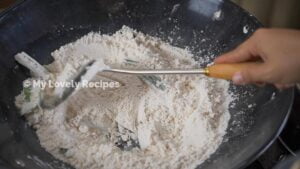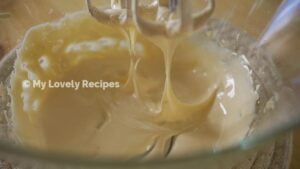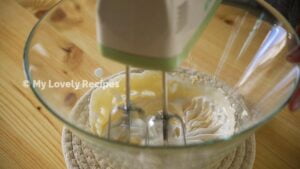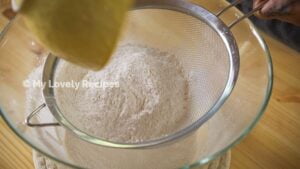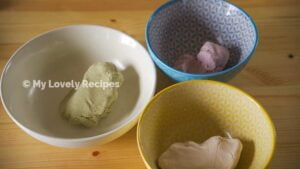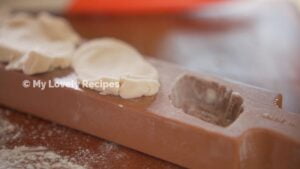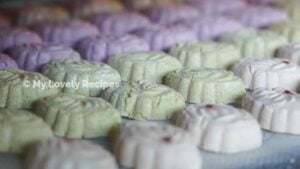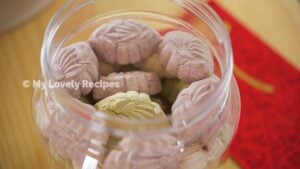We would like to share with you a new year cookie called Kuih Bangkit, some people call it Kueh Bangkek, and the Chinese name is Fan Po Bing or Coconut Cookies. It tastes very dry, but it melts in the mouth and has a full coconut fragrance. In this issue, we will share the making of three flavors of Kuih Bangkit!
Fried Sago Starch
The purpose of fried powder is to evaporate the excess water in the powder. Then the water absorption of the powder will become stronger, and the more coconut cream that can be absorbed will make it more fragrant. Pour the sago powder into the dry pan first, the fried powder will become lighter and less. Therefore, it would be more conservative to fry more than 100 grams of powder. At the same time, prepare a few pandan leaves and dry them with a cloth to ensure that there is no water. Then, cut small pieces and add them to the pot. This can add a little fragrance to the powder and also let us know that the powder has been fried enough. As long as the pandan leaves can be crushed, it means that the powder has been fried enough. The powder that has not been fried will easier gather together and weigh more when they are picked up. Turn on low heat and stir fry gently. This process takes about 10 minutes. When there has the effect of flying snowflakes, it means you can turn off the heat. You can clearly feel that the powder has become loose and the weight has become lighter.
In addition to sago starch, I also tried to use tapioca flour to make Kuih Bangkit. Tapioca flour is relatively absorbent, and you need to add more coconut cream to knead it into a dough. In terms of taste, tapioca flour is not so dense. Different powders have their own unique smell, you can try which one you like.

Concentrated Coconut Cream
Concentrated coconut cream is required to make Kuih Bangkit, because the less water, the cookies will not harden and achieve a melting taste in the mouth. So remember to look carefully at coconut cream when buying. The first method is to heat the coconut cream to evaporate the excess water. Also use low heat, the unheated coconut cream is a very liquid texture. The heating process is about 5 minutes, and the stirring must be kept to avoid scorching the bottom. When there is moisture in the coconut cream, the bubbles are dense after heating. When the water evaporates, the bubbles will be like lava. After cooling, the coconut cream will become thicker.
The second cold extraction method is to put the coconut cream in the refrigerator overnight, let the excess water separately, and then gently scoop out the upper layer of concentrated coconut cream. In terms of texture, it is not as thick as it has been heated, and in terms of taste, it tastes smooth and lighter but not so strong and It takes a long time. The taste is very subjective. Some people say that the coconut cream will smell oily after heating, but I think it’s ok not to overheat it until it oxidizes. You can try to see which one you like and see which way you think suits you.

Making Kuih Bangkit
The egg yolk is beaten to make the cookies rise a little while baking. Then the cookies will be looser when you eat them, and they will loosen when you press them lightly with your tongue. The whipped egg yolk paste will become lighter color and smoother. Then add the concentrated coconut cream and mix well with a whisk at low speed. Then, sift the fried sago starch, stir evenly with a spatula, and then press it with your hands to form a dough. Divide into 3 doughs and add different flavored powders. How much powder you need to add to taste depends on your personal preference. If the dough is wet, add more flour. If it is too dry to form a dough, add a little coconut cream. The kneaded dough should be dry and hard.
Stir evenly with a little red yeast rice powder and a few drops of water, then use it to decorate the white Kuih Bangkit, so that it has a natural red color. You know la, the Lunar New Year festival prefers a little red decoration. Finally, put the prepared cookies into the middle layer of the oven that has been preheated to 160 degrees Celsius, and bake them at 160 degrees Celsius for 28 minutes. Please adjust the temperature and time according to the temper of your oven, and take it out to let cool after baking. Wait until the cookies are completely cool before putting them in the container. This recipe can make about 60 pieces, which is enough to fill a small container.
If you like the recipe of Kuih Bangkit, please share it with your relatives and friends~ Have a nice day!
You may like our other CNY Cookies recipes. Honeycomb Cookies & Pineapple Tarts


Kuih Bangkit
Please Click 1-5 Star to Rate This Recipe
Print Pin Comment & RateEQUIPMENT
- Kuih Bangkit Mold
INGREDIENTS
- 240 g Sago Starch fried
- 1 Egg Yolk about 18g
- 60 g Icing Sugar
- 80 g Concentrated Coconut Cream
- 0.25 tsp Salt
- 1 tsp Purple Sweet Potato Powder
- 2 tsp Pandan Powder
- 3 pcs Pandan Leaves
INSTRUCTIONS
- Wipe the pandan leaves dry and cut them into small pieces, put them in a pot and pour sago starch, stir-fry them over low heat until the pandan leaves can be crushed, and let them cool for later use.

- Pour the coconut cream into the pot and boil it over low heat until the bubbles are in a lava state, then turn off the heat and let it cool for later use.

- Beat the egg yolks, icing sugar, and salt with a whisk at low speed until the color becomes lighter and smooth.

- Add the cooled concentrated coconut cream and mix well with a whisk at low speed.

- Sift and add the fried sago starch and stir evenly until mixed well.

- The dough can be divided and added with different flavors and amounts of plant powder according to personal preference. If the dough is too dry, add a little concentrated coconut cream, otherwise, add a little powder.

- After spreading the fried sago starch on the baking tray and mold, then knocking out the excess powder in the mold, press the dough into the mold forcefully. Cut off the excess dough and knock it out.

- Put the Kuih Bangkit in the middle rack of the oven and bake them at 160 degrees Celsius for 28 minutes.

- After baking, let it cool before putting it in a container.

INSTRUCTIONS VIDEO
NUTRITION

We are Penangites who love to COOK & EAT, so we are sharing the food we love with you. Know more about us…
